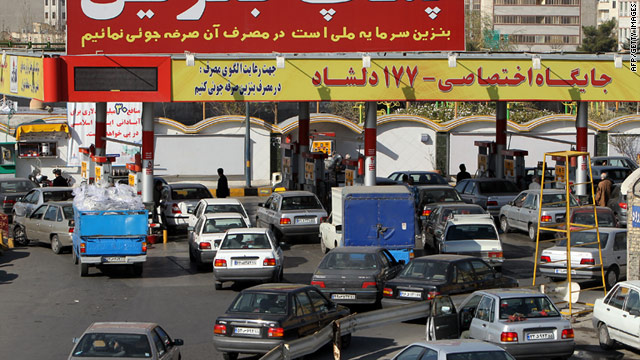by Sara Vakhshouri
This week Iranians began dealing with a new phase of reduced fuel subsidies and increased gasoline prices. The new gasoline prices were announced at midnight on April 24 by the National Iranian Oil Refining and Distribution Company (NIORDC).The price for the semi-subsidized gasoline will be 7,000 rials per liter (27 cents) and 10,000 rials (42 cents) for free market price gasoline. That’s a considerable jump from the 4,000 rials (16 cents) per litre for the semi-subsidized gasoline and 7,000 rials for free market price gasoline.
The current gasoline subsidy reductions are part of the “second phase” of the subsidies reform plan in Iran, which was passed by the Parliament on January 5, 2010. The government announced that people could still use the remaining share of the subsidized gasoline with the previous price in their fuel cards after the price change. Each car has a fuel card with 60 liters of semi-subsidized gasoline a month and once they use up their share, they will have to purchase gasoline at the free market price.
Following the price increase announcement, the average consumption of gasoline in Iran spiked massively. Average gasoline consumption in Iran fluctuates between 66 and 70 million liters per day. This number reaches over 70 million during seasons of high demand, particularly around the Persian New Year in March. Of course, this past week average gasoline consumption increased significantly. According to the NIORD, gasoline consumption on Saturday, April 19, rose to 80.7 million liters — and the next day it reached 94 million. Although this number eventually dropped back to 76 million liters, it was still up 6 million a day from the previous week. The spike in gasoline consumption strongly suggests that people are storing gasoline in anticipation of their remaining subsidized shares being cancelled. The head of Iran’s Gas Station Owners Association, Bijan Haj Mohammadreza, said that Iranians are “storing gasoline in non-standard containers” in anticipation of rising prices.
Indeed, domestic gasoline supply and the direct influence of its prices on inflation and standards of living have always been Iran’s Achilles’ heel. Subsidized gasoline prices have created an expectation of, if not demand for, lower prices. This is something that the government in Tehran has to manage. The subsidies reform plan has thus far helped the Iranian government somewhat control domestic gasoline consumption, and to a certain degree also aided efforts aimed at preventing smuggling to neighboring countries.
Why Iran needs subsidy reform
Reducing Iran’s gasoline subsidies would initially reduce the gap between international and domestic prices. It would also help the government save money and better manage its domestic consumption. According to Iran’s Fifth Five-Year Development Plan, domestic gasoline prices should rise to about 90 percent of the free on board prices of the Persian Gulf by the end of the fifth plan in the next year and half.
However, Iran’s current gasoline prices lag far behind the plan. The inflation resulting from sanctions, coupled with currency devaluation, has prevented the government from increasing gasoline prices since 2011. The rial’s devaluation has also increased the gap between international and domestic gasoline prices. The first phase of Iran’s subsidies reform was attempted by former President Mahmoud Ahmadinejad. At that time, the US dollar amounted to about 10,000 rials, and Iran could mange an increase in gasoline prices from 10 to 40 cents a liter (at the previous price of 4,000 rials a liter). Yet for the past two years, with gasoline prices at the same rate of 4,000 rials, prices once again were forced down to 16 cents a liter.
Petrochemical facilities halting gasoline production
Iran’s dependency on gasoline imports has been a bottleneck issue for the country. During the Ahmadinejad government, Iranian petrochemical factories started to change their production line in order to produce gasoline and reduce their dependency on imports. Iranian petrochemical facilities managed to produce gasoline with 95 octanes, which is generally considered a good quality gasoline. However, the aromatic contents of this gasoline fell well short of international standards, and significantly contributed to air pollution, particularly in Tehran.
However, the “petroleum team” of Iran’s new president has stated on different occasions that Iran is planning to increase its gasoline imports to reduce air pollution. Aside from making air more breathable, this would also, crucially, allow petrochemical factories to return to their planned production line and produce higher profits by exporting their products to the international markets.
Iran currently imports around 3.5 million liters of gasoline a day. According to the director of NIORDC, Abbas Kazemi, this number will increase almost threefold to almost 10 million liters per day. Iranian refineries currently produce around 60 million liters of gasoline a day, up from the 48 million liters per day they produced in 2012.
Over the past few years Iran has been planning to increase its refinery capacity and gasoline production. Iranian petroleum officials are aiming for self-sufficiency by March of 2015, when construction on the Persian Gulf Star Refinery is expected to be complete. Based in Assalouyeh, South Pars, this refinery has a total capacity of processing 360,000 barrels of gas condensate. Seventy-five percent of this gas condensate will be converted to gasoline and diesel oil.
Iran’s current gasoline subsidies reduction plan, which is part of a broader attempt at reforming Iran’s subsidies, could stoke inflation, which will be tough for average Iranian families. But in the long-term, this strategy will help Iran manage its domestic fuel consumption, which will save money for the Iranian government and increase the value of its petroleum products.






Isn’t gasoline always the Achilles heal in every society that depends upon it for their daily transportation use, especially if they are on the lower wage earners scale? Governments use the subsidized form as a means of control, though in the U.S., the gasoline producers are the ones who receive the subsidized costs, not he consumer, along with all the other perks the oil companies receive.
Wow, wow and wow again! Similar gasoline prices had the Libya under Gaddafy. What an ugly governments under Gaddafys, Chavezis, Maduros and Ayatollahs of this world think of market prices of this precious commodity. Of course we have to bomb them, kill them all, and make some nice profits. Or maybe to be subversive on them and chase them out of the power with some nice color-revolution, so they do not break our business.By the way – anybody knows what price of gasoline is in Israel? It would be just interesting to know it – sorry for out of topic thought.
Generally speaking, Iran wastes a lot of its energy. The per-capita gas consumption is either the highest, or near the top in the world for example, fortunately they have more than ample supplies. Even though the Iranian automotive scene is dominated by smaller vehicles, so long as gasoline is cheaply attainable via government subsidies, many believe that consumption will be higher than if there were no subsidies, as some of the non-critical driving may be abated. However, as time and again market has proven, this phenomenon is temporary and once consumer is used to the new price level consumption will resume its previous growth curve. The main challenge in Iran is to provide additional refining capacity, along with alternative means of transportation, and/or, alternative fuels such as the abundant natural gas. Iran does have the means to convert gasoline engines into dual fuel usage, perhaps an interim solution to both the pollution problem and lack of gasoline supplies may rest in a more aggressive conversion of engines into dual fuel capability. Many cabs in Tehran currently have this dual fuel mode, why not have it for more vehicles?
With thanks to Sara, I clarify that the US dollar price at time of president Ahmadinezad was 10,000 rials not 1000 rials which is mistake. Meanwhile now it swing around 30000 rials.